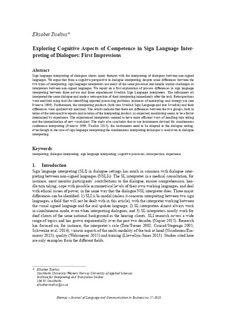| dc.contributor.author | Tiselius, Elisabet | |
| dc.date.accessioned | 2019-09-24T07:35:59Z | |
| dc.date.available | 2019-09-24T07:35:59Z | |
| dc.date.created | 2019-03-14T11:05:37Z | |
| dc.date.issued | 2018 | |
| dc.identifier.citation | Tiselius, E. (2018). Exploring cognitive aspects of competence in sign language interpreting of dialogues: First impressions. HERMES - Journal of Language and Communication in Business, 57, 49-61. | nb_NO |
| dc.identifier.issn | 0904-1699 | |
| dc.identifier.uri | http://hdl.handle.net/11250/2618362 | |
| dc.description.abstract | Sign language interpreting of dialogues shares many features with the interpreting of dialogues between non-signed languages. We argue that from a cognitive perspective in dialogue interpreting, despite some differences between the two types of interpreting, sign language interpreters use many of the same processes and handle similar challenges as interpreters between non-signed languages. We report on a first exploration of process differences in sign language interpreting between three novice and three experienced Swedish Sign Language interpreters. The informants all interpreted the same dialogue and made a retrospection of their interpreting immediately after the task. Retrospections were analyzed using tools for identifying reported processing problems, instances of monitoring, and strategy use (see Ivanova 1999). Furthermore, the interpreting products (both into Swedish Sign Language and into Swedish) and their differences were qualitatively analyzed. The results indicate that there are differences between the two groups, both in terms of the retrospective reports and in terms of the interpreting product. As expected, monitoring seems to be a factor determined by experience. The experienced interpreters seemed to have more efficient ways of handling turn taking and the internalization of new vocabulary. The study also concludes that to use instruments devised for simultaneous conference interpreting (Ivanova 1999; Tiselius 2013), the instruments need to be adapted to the dialogue setting, even though in the case of sign language interpreting the simultaneous interpreting technique is used even in dialogue interpreting. | nb_NO |
| dc.language.iso | eng | nb_NO |
| dc.publisher | Institut for Kommunikation og Kultur, Aarhus Universitet | nb_NO |
| dc.relation.uri | https://tidsskrift.dk/her/issue/view/7563 | |
| dc.rights | Navngivelse 4.0 Internasjonal | * |
| dc.rights.uri | http://creativecommons.org/licenses/by/4.0/deed.no | * |
| dc.subject | Tegnspråktolking | nb_NO |
| dc.subject | Sign Language Interpreting | nb_NO |
| dc.subject | Tolkvitenskap | nb_NO |
| dc.subject | Interpreting Studies | nb_NO |
| dc.title | Exploring cognitive aspects of competence in signed language interpreting: First impressions | nb_NO |
| dc.type | Journal article | nb_NO |
| dc.type | Peer reviewed | nb_NO |
| dc.description.version | publishedVersion | nb_NO |
| dc.rights.holder | © The Author. | nb_NO |
| dc.subject.nsi | VDP::Anvendt språkvitenskap: 012 | nb_NO |
| dc.subject.nsi | VDP::Applied linguistics: 012 | nb_NO |
| dc.source.pagenumber | 49-61 | nb_NO |
| dc.source.volume | 57 | nb_NO |
| dc.source.journal | Hermes - Journal of Language and Communication Studies | nb_NO |
| dc.identifier.doi | 10.7146/hjlcb.v0i57.106193 | |
| dc.identifier.cristin | 1684703 | |
| cristin.unitcode | 203,10,3,0 | |
| cristin.unitname | Institutt for språk, litteratur, matematikk og tolking | |
| cristin.ispublished | true | |
| cristin.fulltext | original | |
| cristin.qualitycode | 1 | |

